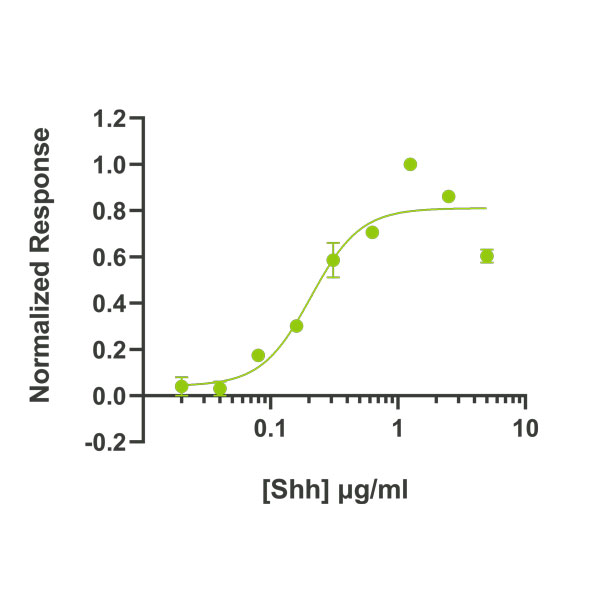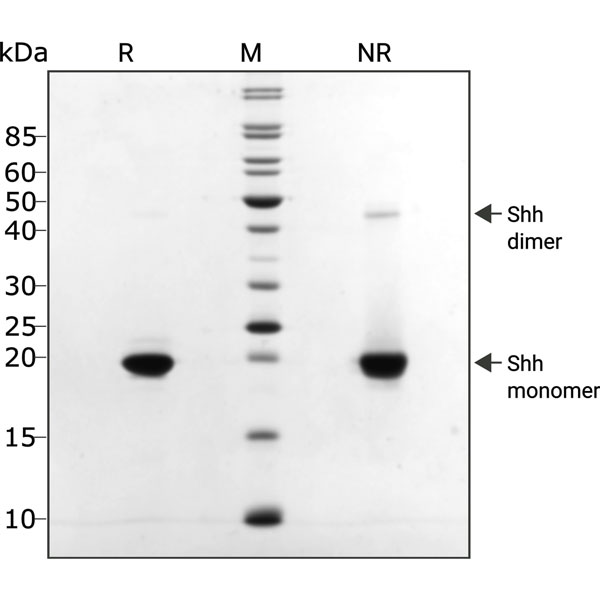Currency
Recombinant human Shh protein (Qk055)
Sonic hedgehog protein (Shh) is a member of the Hedgehog family with an essential role in embryonic development, tissue regeneration, and tumorigenesis. Shh induces the cell fate and patterning of neural progenitors in ventral domains at various levels in the forebrain, midbrain, hindbrain, and spinal cord. It has many applications in the neural stem cell field where it plays a significant role in differentiating human-induced pluripotent stem cells (iPSC) towards motor neurons and interneurons. Also, it induces the patterning of organoids and embryos in culture.
Recombinant Shh protein has a molecular weight of 19.8kDa. This protein is animal origin-free (AOF), carrier protein-free, and tag-free to ensure its purity with exceptional lot-to-lot consistency. Sonic hedgehog protein is suitable for the culture of reproducible and high-quality neurons and organoids.
Orders are typically shipped same or next day (except Friday).
Easy world-wide ordering, direct or through our distributors.
1000µg will be despatched as 2 x 500µg
Fast and free shipping.
Buy online with secure credit card or purchase order.
For any questions, please email orders@qkine.com
Summary
High purity sonic hedgehog protein (Uniprot: Q15465)
>98%, by SDS-PAGE quantitative densitometry
19.8 kDa (monomer)
Expressed in E. coli
Animal origin-free (AOF) and carrier protein-free
Manufactured in Cambridge, UK
- Lyophilized from PBS
Resuspend in water at >100 µg/ml, prepare single use aliquots, add carrier protein if desired and store frozen at -20 oC (short-term) or -80 oC (long-term).
Featured applications
Neural differentiation
Midbrain differentiation
Ventral forebrain differentiation
Corpus organoid generation
Cholinergic-like neurons (ChLNs) differentiation
Dopaminergic neurons differentiation
Hhg-1, SHH, HHG1, HLP3, HPE3, MCOPCB5, SMMCI, TPT, TPTPS, sonic hedgehog, Sonic hedgehog, ShhNC, sonic hedgehog signaling molecule
Human
Species protein similarity:
mouse – 99.4%
rat – 97.7%
porcine – 98.85%
bovine – 99.4%
Frequently used together
Bioactivity

The bioactivity of sonic hedgehog protein (Qk055) is determined by its ability to induce alkaline phosphatase production by C3H/10T1/2 (CCL-226) cells. The EC50 for this effect is 0.21 µg/ml (10.6 nM). Cells were incubated with different concentrations of Shh for 5 days before alkaline phosphatase measurement. Data is n=2, from Qk055 batch #104376.
Purity

Human Shh (Qk055) migrates as a major band at 19.8 kDa in non-reducing (NR) conditions. We load 3 ug of protein to ensure good visibility of protein in the gel. This allows you to see the faint Shh dimer band at 40 kDa in the non-reduced sample. Shh spontaneously forms non-covalent dimers, this is thought to increase its potency (10). Upon reduction (R), only the 19.8 kDa band is visible. No contaminating protein bands are visible. Purified recombinant protein (3 µg) was resolved using 15% w/v SDS-PAGE in reduced (+β-mercaptoethanol, R) and non-reduced (-β-mercaptoethanol, NR) conditions and stained with Coomassie Brilliant Blue R-250. Data from Qk055 batch #104391.
Further quality assays
Mass spectrometry: single species with expected mass
Endotoxin: <0.005 EU/μg protein (below level of detection)
Recovery from stock vial: >95%
We are a company founded and run by scientists to provide a service and support innovation in stem cell biology and regenerative medicine. All our products are exceptionally high purity, with complete characterisation and bioactivity analysis on every lot.
Protein background
Sonic Hedgehog protein (Shh) is a member of the Hedgehog family, which also includes Indian-Hedgehog (Ihh) and Desert-Hedgehog (Dhh) [1-4]. Shh is essential in embryonic development, tissue regeneration, and tumorigenesis. Shh regulates cell fate and patterning of tissues, in particular the neural tube and eventually the central nervous system [5-7]. It plays a significant role in patterning ventral forebrain fate in the forebrain region, dopaminergic neural destiny in the midbrain region, and serotonergic neural fate in the hindbrain region. Shh instructs the neural progenitors’ patterning and induces motor neurons and interneurons [5]. Shh is important in adult tissue maintenance and repair during stem cell differentiation and tissue regeneration [8,9].
In cell culture, Shh has many applications in the embryonic development and neural stem cell field. Shh is used to pattern embryos and organoids towards the neural axis [10,11]. Sonic Hedgehog signaling is crucial in deriving neural progenitors from induced pluripotent stem cells [12-14]. Further differentiation into more mature neurons using a combination of different growth factors. Dopaminergic neurons are obtained using brain-derived neurotrophic factor (BDNF), glial cell line-derived neurotrophic factor (GDNF), FGF-8a/FGF-8b [15-17], TGF-β3, and Shh [15-17]. GABAergic neurons are obtained using BDNF, GDNF, insulin-like growth factor 1 (IGF-1), and Shh [18-20].
Shh is released by various cells during embryonic development, including the notochord cells forming the neural tube. Shh encodes a 462 amino acid precursor protein, which is autocatalytically processed to yield a 19 kDa N-terminal fragment (ShhN) and a 25 kDa C-terminal protein (ShhC). Lipids modify the N-terminal fragment to produce the mature, activated signaling molecule, which is then secreted from the cell [21]. SHH C24II is the bioactive N-terminal region, encompassing Cys24-Gly197 (Cys24Ile-Ile). It can signal via canonical and non-canonical pathways. Shh binds to Patched (Ptch), a transmembrane protein that plays a crucial role in the Hedgehog signaling pathway involved in tissue patterning during embryogenesis [22].
The implications of Shh dysregulations in developmental disorders and diseases such as cancer have gained interest in treatment development. Abnormal Shh signaling has been associated with basal cell carcinoma and medulloblastoma, where research is ongoing to find potential inhibitors of the Shh pathway to treat cancer [23,24]. Inhibitors to the Shh pathway are also relevant to treating development disorders such as Gorlin syndrome, which predispose affected individuals to basal cell carcinoma [25]. Finally, the role of Sonic Hedgehog in tissue regeneration makes it a potential therapeutic strategy in regenerative medicine [26].
FAQ
Recombinant human Sonic Hedgehog (Shh) protein is a laboratory-produced version of the Sonic Hedgehog protein.
Shh regulates cell fate and patterning of tissues, in particular the neural tube and eventually the central nervous system.
Shh is produced by various cells during embryonic development including the notochord cells, the floor plate cells, and the Zona Limitans Intrathalamica (ZLI) Cells.
Shh is activated and induced by a combination of molecular cues and developmental signals. Shh also autoregulates and low levels of Shh will induce Shh release.
Shh is a morphogen which belongs to the Hedgehog family of proteins.
The name “Sonic Hedgehog” may sound unusual, but it’s derived from the imaginative and whimsical naming tradition in developmental biology. The Hedgehog gene and its associated protein family were initially identified in Drosophila, a species of fruit fly. It was named “hedgehog” due to the fly’s spiky appearance when the gene was mutated. The reference to “Sonic” adds a playful and distinctive touch to the name, likely inspired by the popular video game character Sonic the Hedgehog, known for his speed and spiky appearance. So, while the name might appear unconventional, it reflects the imaginative and playful spirit within the scientific community.
Sonic Hedgehog (SHH) and Indian Hedgehog (IHH) are members of the Hedgehog family of proteins but SHH regulates the embryonic development such as the neural tube whereas IHH mediates the developing bone and cartilage.
The SHH gene is highly conserved across species and is present in all mammals, as well as birds, reptiles, amphibians, and some fish. Shh is also present in some invertebrates like Drosophila.
Shh is expressed during the embryonic development, the neural tube for central nervous patterning, the maintenance of stem cell populations, and tissue repair processes.
The SHH signalling pathway is also referred to the Hedgehog pathway and is involved in embryonic development and tissue homeostasis.
Our products are for research use only and not for diagnostic or therapeutic use. Products are not for resale.



What others are saying
There are no contributions yet.